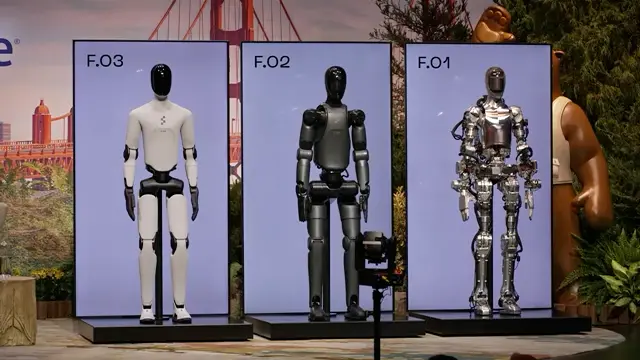- Published on
Figure CEO Claims General-Purpose Robots Are Arriving "Next Year"

SAN FRANCISCO – In a conversation at the Dreamforce conference, Figure CEO Brett Adcock laid out one of the most aggressive timelines to date for the arrival of truly autonomous, general-purpose humanoid robots. Speaking with Salesforce CEO Marc Benioff, Adcock claimed that the primary obstacle in the field is not manufacturing, but solving intelligence, and predicted his company would achieve this milestone far sooner than most expect.
Flanked by static models of the company’s three robot generations—Figure 01, 02, and 03—Adcock argued that the industry is at a turning point. "The manufacturing problem.. it's like problem number 50," he said. "The race right now for humanoids is who can solve general robotics".

An Aggressive Timeline Focused on AI
Adcock's most striking claim was a concrete prediction for when a humanoid could perform a wide range of tasks based on voice commands in an unfamiliar setting. "I think we'll be able to do general purpose work with a humanoid by just through speech and have it do everything you'd want it to do in unseen places like a home it's never been in next year," he stated.
He positioned Figure as being "multiple one or two years beyond anybody else in the world", estimating it would take competitors five years to reach a similar position.
This confidence, he explained, stems from the company's focus on solving the software and intelligence challenge, which he described as a problem of immense scale. A humanoid has 40 degrees of freedom, or joints, leading to a number of possible positions greater than the number of atoms in the universe. "You can't code your way out of this problem," Adcock said, adding that the only solution is through neural networks.
He contrasted Figure’s approach with others in the field, dismissing some public demonstrations as "open loop theatrics" or pre-programmed routines. In contrast, he said, the tasks Figure's robots perform are "done by a neural network", citing their ongoing work at a BMW manufacturing plant in Spartanburg, where a robot has been operating 10 hours a day since April.
Leaning on the Human Form Factor
According to Adcock, the key to solving the intelligence problem is leveraging the "unfair advantage" of the humanoid form. Because the robots share the same basic structure as humans, they can learn from the vast repository of existing human video data to navigate spaces and manipulate objects. This strategy is central to the design of the company’s latest robot, the Figure 03, which was engineered with a sophisticated sensor suite specifically to support its "Helix" AI model.

This learning is collective. "Once one robot knows how to move packages or do your dishes or whatever, every robot in the fleet knows this," he said.
While downplaying manufacturing as the most critical current problem, Adcock confirmed the company is scaling up. Figure has established a facility called "BotQ" where it is "trying to make thousands of robots". The facility, detailed in the Figure 03 announcement, is designed with an initial capacity of 12,000 robots per year. He also revealed that the company intends to put its own robots on its manufacturing line this year, a first step toward a long-term vision of self-replicating systems.
A Sci-Fi Vision with Civilian Focus
Adcock's long-term vision is ambitious, referencing concepts like self-replicating Von Neumann probes colonizing the galaxy and building a company worth "tens of trillions" of dollars. "We're not building robots, we're building a new species, really," he remarked.
Despite the futuristic scope and questions about potential military applications, Adcock was clear about the company's current focus. After being repeatedly contacted by the Department of Defense, he stated that Figure has no interest in militarizing its technology. "It's just like not interesting for us," he said. "Shipping robots in the home and the workforce. That's what gets us excited".
For now, the vision of a galaxy populated by autonomous machines remains science fiction. But if Adcock's timeline holds, the first proof points for a world populated by general-purpose humanoids could arrive much sooner than anyone thought.
Share this article
Stay Ahead in Humanoid Robotics
Get the latest developments, breakthroughs, and insights in humanoid robotics — delivered straight to your inbox.